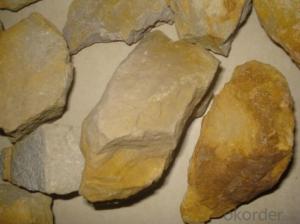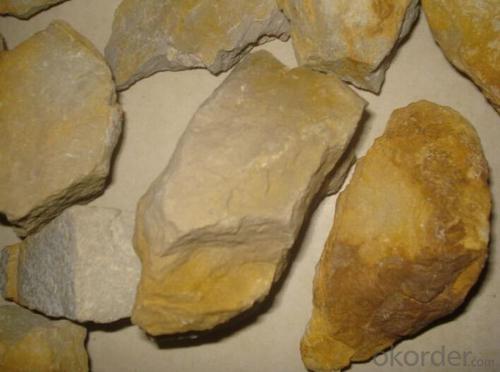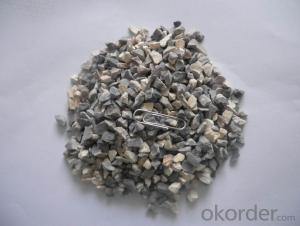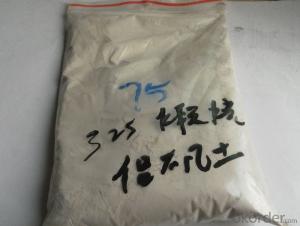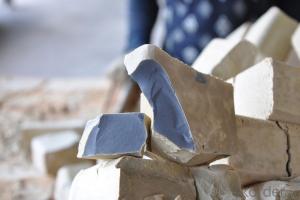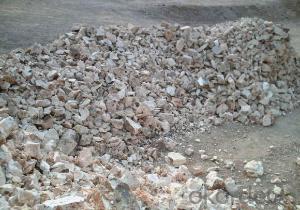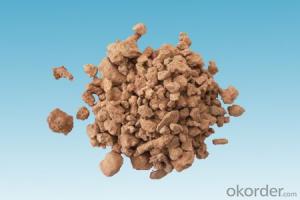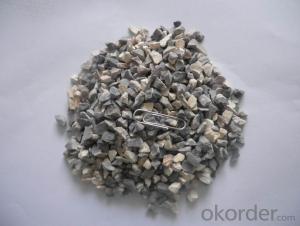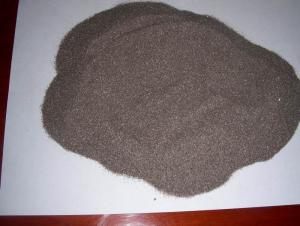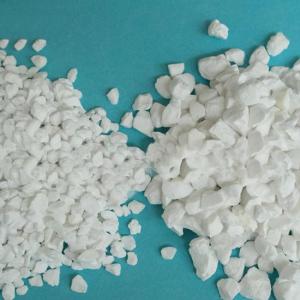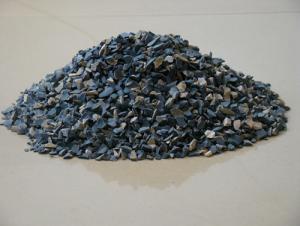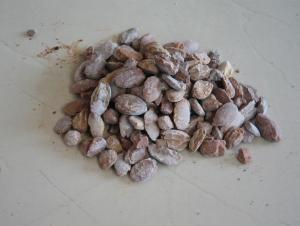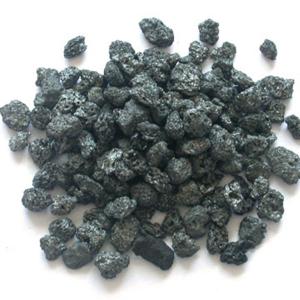Raw Materials for Refractory - Natural Bauxite Lump for Cement Industry in China CNBM
- Loading Port:
- Tianjin
- Payment Terms:
- TT or LC
- Min Order Qty:
- 20000 m.t.
- Supply Capability:
- 10000000 m.t./month
OKorder Service Pledge
OKorder Financial Service
You Might Also Like
1. Structure of Calcined Bauxite Description
Natural Bauxite Lump for Cement Indystry in China CNBM
Bauxite (aluminous soil; Bauxite) is also called the alumina or bauxite; main ingredients are alumina, hydrated alumina containing impurities, is an earthy mineral. The color is white or gray, brown and yellow or light red by iron. From 4 to 3.9 g/cm3 density, hardness, 1 ~ 3 is not transparent, very brittle, very difficult to melt. Insoluble in water, soluble in sulfuric acid, sodium hydroxide solution. Mainly used for aluminium, refractory material.
2. Main Features of the Calcined Bauxite
Natural Bauxite Lump for Cement Indystry in China CNBM
Calcined bauxite is one of the principal ore of aluminum. Calcined bauxite contains hydrous aluminum oxides and aluminum
hydroxides, formed through the laterization of aluminous rocks in tropical and subtropical areas .Calcined bauxite is obtained by calcining (heating)superior grade bauxite at high temperature (from 85OC to 1600C) .This removes moisture there. By increasing the alumina content,compared to an alumina content of about 57%to 58% in raw bauxite, calcined bauxite has an alumina content of 84%to88%.The heating is carried out in rotary kilns.
3. Calcined Bauxite Images
Bauxite Mineral Used for Aluminum Making Originated in China
4. Calcined Bauxite Specification
Natural Bauxite Lump for Cement Indystry in China CNBM
Rotary Kiln Calcined Bauxite SEMI L.F Specification : Al2O3 : 83.00 + % Fe2O3 : 3.5 % SIO2 : 5 To 6% Cao : 2.5% TIO2 : 4 % , Size : 0-1MM OR 1-3MM
Rotary Kiln Calcined Bauxite G.G.NO.1 Specification : Al2O3 : 80.00 + % Fe2O3 : 3.8 % SIO2 : 6 To 8% Cao : 2.2 To 2.5% TIO2 : 5 To 6 % , 0-1MM OR 1-3MM
Rotary Kiln Calcined Bauxite G.G No.2 Specification : Al2O3 : 78 % Fe2O3 : 4 TO 4.2% SIO2 : 8 To 9 % TIO2 : 6.00 % Cao : 2.50 % , Size : 0-1MM OR 1-3MM
Rotary Kiln Calcined Bauxite G.G No.3 Specification : Al2O3 : 75 % Fe2O3 : 4 TO 4.5% SIO2 : 9 To 11 % TIO2 : 5.00 % Cao : 3.00 % Size : 0-1MM OR 1-3MM
Or as per buyes requirements.
5.FAQ of Calcined Bauxite
Natural Bauxite Lump for Cement Indystry in China CNBM
1). Q: Are you a factory or trading company?
A: We are a factory.
2). Q: Where is your factory located? How can I visit there?
A: Our factory is located in ShanXi, HeNan, China. You are warmly welcomed to visit us!
3). Q: How can I get some samples?
A: Please connect me for samples
4). Q: Can the price be cheaper?
A: Of course, you will be offered a good discount for big amount.
- Q: In entering fire door, which material does well?
- Entering door has two kinds: security doors, fire security door. The pure fire door does not have anti-theft function. In the relevant technical standards of fire doors : when in the fire, it can make residents in a few seconds or 1 minutes forget to open the door... The material of fire door, fire door has steel fire door and wooden fire door. There is no doubt that wooden fire door can't be used as entering door. In the steel fire door, two layers of steel plate in the clip is flame retardant material.
- Q: What kind of refractory materials are used in metallurgy industry?
- Argon-blowing rod, siliceous dry vibrating materials, desulfurizer, slag-stopping ball, stainless steel thermal insulating agent with high efficiency, dry vibration material, sizing nozzle heat-insulating panel, chrome refractory , refractory carstables for ladles, magnesia carbon refractory, package castable, siliceous drainage agent, tundish block, iron trough, deoxidizer, compound deoxidizer,silicon manganese alloy , stemming, floating plug,slagging agent. The main materials are as follows: recarburizer, covering agent, intermediate frequency furnace burden, mould fluxes, insulation thin slag agent, skimmer repair material, joint sealant.
- Q: who knows the uses of refratories?
- Physical properties of refractories include structural properties, thermal properties, mechanical properties, usability and operation. structural properties of refractories include porosity, bulk density, water absorption, air permeability, pore size distribution. Refractory thermal properties include thermal conductivity, thermal expansion coefficiency, specific heat, heat capacity, thermal diffusivity, thermal emissivity. Mechanical properties of refractories include compression strength, tensile strength, anti bending strength, torsional strength, shear strength, impact strength, abrasion resistance, creep property, adhesive strength, modulus of elasticity. Refractories are used in various fields of steel, nonferrous metals, glass, cement, ceramics, petrochemical, machinery, boilers, light industry, power, military and other fields of national economy. They are essential materials that ensures the production run and technological development of the above industries, and play an important role in promoting the developemnt of high temperature industrial production. the usability of refractories include refractoriness, softening temperature under a fixed load, linear?change?on?reheating,thermal shock resistant performance,slag resistance, acid resistance, alkali resistance, hydration resistance, carbon monoxide resistance, conductivity, oxidation resistance.
- Q: How to make use of waste refractory materials whose main elements are alumina and mullite?
- Crushing and pressing refractory bricks, or refractory parts . Such as welding positioner tracks use disposable tools.
- Q: What is the most reasonable drying heating curve of magnesia refractories? Products of less than 0.5T
- o
- Q: whether the aluminum silicate thermal insulation material is fireproof or not?
- aluminum silicate is fireproof, and the melting point is between -40 ~ 800 ℃. Aluminum: it takes the flint clay clinker as raw material, produced by resistance or electric arc furnace fusion and injection fiber-forming process. its characteristics: Low thermal conductivity, excellent thermal and chemical stability, without binder and corrosive material.
- Q: What are refractory materials?
- Refractories can be divided to two categories based on the shape and three categories according to the chemical nature of acidity, neutralily and alkalinity. Alkaline refractory materials are magnesia-carbon brick, magnesia chrome brick, calcium magnesium brick and magnesia-chrome bricks. Neutural refractory mateial are high alumina brick, corundum brick and clay brick. Case-hardened refractory materials are castable, ramming mass, gunning mix, coated mix, dry vibration material, etc.
- Q: The principle of choosing fire-resistant material in Thermal Energy and Power Engineering equipment.
- What thermal equipment? The most simple principle is durable, low cost and with no environmental pollution.
- Q: What are the differences of ceramics and refractories? Is the ceramics belonging to refractories?
- Ceramic pottery ceramic collectively known species of high water absorption and low-grade sinter clay brick, tile-like material; high stone kinds of porcelain clay plus clay and other raw sintered body strength, low water absorption bowls, plates and other kinds of refractory high temperature structural materials are all non-machine ceramic refractory metal material belonging to a broader definition of ceramic refractory ceramic can be attributed to the high temperature ceramic refractory.
Send your message to us
Raw Materials for Refractory - Natural Bauxite Lump for Cement Industry in China CNBM
- Loading Port:
- Tianjin
- Payment Terms:
- TT or LC
- Min Order Qty:
- 20000 m.t.
- Supply Capability:
- 10000000 m.t./month
OKorder Service Pledge
OKorder Financial Service
Similar products
Hot products
Hot Searches
Related keywords
